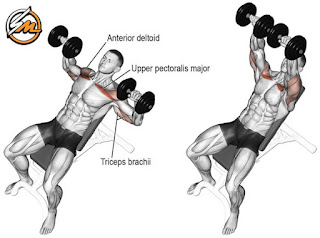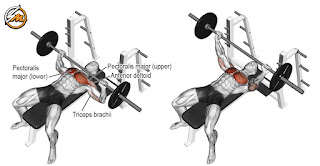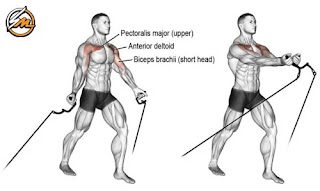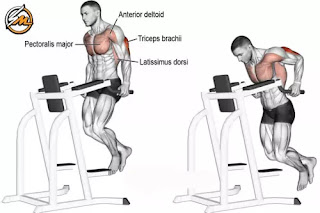Mondays are referred to as "International Chest Day" for a reason: Having a strong set of pecs may completely alter your appearance. Along with helping you perform better in sports like powerlifting and gymnastics, a strong chest may also help you look good at the beach or pool this summer.
Even while the basic bench press lives up to its reputation as a terrific workout for both strength and size, developing your chest might require more thought than simply performing the standard five sets of five repetitions. If you know what you're doing, especially targeting the upper chest can improve your overall appearance.
Best Upper Chest Exercises
Incline Hex Press
When it comes to breaking down muscles so they can recover larger and better, tension is king. Few exercises cause more strain than the hex press, which involves pressing two dumbbells together while squeezing them together. When you perform the hex press on an incline, the weights are angled to put greater pressure on your upper chest. Beware: When performed properly, this movement is immensely humble. Choose 25-pound weights if you regularly push 50- to 60-pound dumbbells.
How to Do the Dumbbell Landmine Press
An adjustable bench should be angled between 30-45 degrees. Grab a pair of fairly difficult dumbbells because the focus of this exercise is on contraction and concentration rather than the maximum weight. Press up and back slightly while the dumbbells are resting on your chest and in contact with one another. As you lower the dumbbells until they softly brush your shirt, keep your elbows tucked in. For the whole exercise, "squeeze" the dumbbells firmly together.
Incline Dumbbell Press
Bodybuilders and powerlifters love this incline dumbbell press because it's a flexible yet difficult exercise that, when done correctly, totally torched the chest and shoulders. The clavicular head of the pecs, or the "upper" chest, plays a major role in shoulder flexion, which is made possible by pressing on an inclined surface. This expanded range of motion ought to significantly boost upper chest fiber activation.
How to Do the Dumbbell Bench Press
An adjustable bench should be positioned with a 25–40 degree slope. Lean back while bracing your core and placing two dumbbells, one on each knee. Use your legs to "kick" the dumbbells into the beginning position as you get into position. Place your feet firmly on the ground, position your elbows so that they are directly below your wrists, and drive the weight up, backward, and inward into your midline.
In the final position, your upper arm should be aggressively pressed against your body as the dumbbells should be close together and right above your shoulder joint. If at all feasible, lower the weights to the chest, then repeat.
Guillotine Press
This unusual action may initially appear to be someone doing a bench press wrong. However, because of the powerful stretch and minimal involvement of the triceps when performed correctly, it is an excellent exercise for the upper chest. The name of the exercise, which is usually done with a barbell, comes from lowering the bar to the neck (or even chin). The severe elbow flare provides an amazing stretch for both pectoralis muscle heads, but proceed with caution—it calls for healthy, mobile shoulders, so warm up well in advance.
How to Do the Guillotine Press
Laying on a level or slightly inclined bench, take a broad grip and unrack an empty or lightly loaded barbell. Maintaining flared elbows, carefully lower the weight straight downward toward the neck or clavicle. Hold the lowest position for a brief period before pressing back up, trying to "bend" the bar into a U-shape. Do not rest the bar on the neck at any point. Before any apparent shoulder ache, stop.
The optimal bar path for this exercise is totally or almost vertical, making a Smith machine an excellent choice for performance. Even though studies indicate that the Smith machine may increase muscle activation and development just as effectively as free weights, it occasionally catches a poor rep.
Low Cable Fly
All of the anatomical tasks that the muscle performs should be trained in a well-designed training regimen. Despite being frequently linked with pushing, the pecs may also pull the arm in a horizontal direction. As a result, a successful chest day must include at least one lateral flye movement, in this case, one that targets the upper chest. The low cable flye is the ideal culmination to your next chest day since you can precisely simulate the shoulder flexion done by the pec minor by angling the cable attachments at a low angle.
How to Do the Low Cable Fly
Take a staggered posture with the wires positioned below the level of your waist. With your palms facing front, let your arms dangle loosely behind your body. With your arm rotated so that your elbows are pointed to the sides at the top, "scoop" the handles up and inward. For a powerful contraction, squeeze your chest and push your upper arm up against your torso. Then, gently return to the beginning position. At no time should you allow your shoulders to slouch?
Weighted Dip
Although the conventional dip is regarded as a calisthenics classic, some athletes can find it too simple to execute. It may be a great conclusion for your next upper-chest-focused exercise with a few slight difficulty modifications, if necessary. The weighted dip fills a range of motion that is not satisfied by the other exercises on this list, making it a fantastic supplement to a training program. Some study indicates that a tighter grip might stimulate the upper chest particularly effective when it comes to pressing variations, even though a wide, straight-arm flye action splits the chest apart.
How to Do the Weighted Dip
A chain draped over the upper back, a weight belt with a plate loop, or a small dumbbell wrapped between crossed ankles are typical methods for loading the dip. Whatever approach enables the most consistency and focus will be effective. Brace your core, suspend yourself from the grips, and depress your scapula. Bend at the elbows and let the upper arm slide behind the torso as you gently drop once you and the weight are motionless. Press yourself back up until your chest feels significantly stretched while maintaining your arms at your sides.
Related article: Best Exercises and Workouts You Need to Build Bigger Pecs











.jpg)
0 Comments